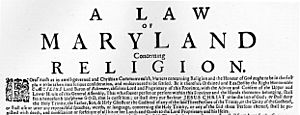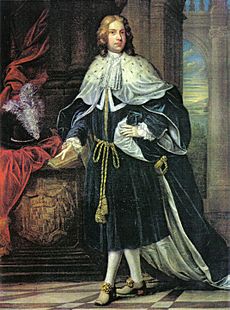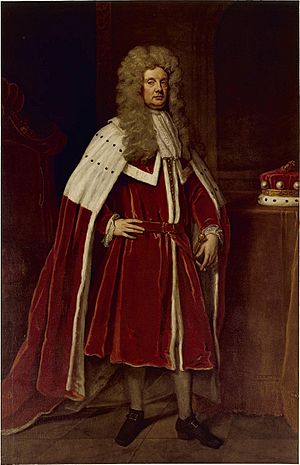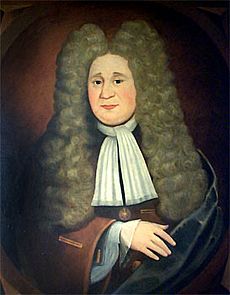Protestant Revolution (Maryland) facts for kids
Quick facts for kids Protestant Revolution |
|||||||
|---|---|---|---|---|---|---|---|
| Part of the Glorious Revolution | |||||||
 A 1685 map of Maryland |
|||||||
|
|||||||
| Belligerents | |||||||
| Puritans | Catholics | ||||||
| Commanders and leaders | |||||||
|
|||||||
| Strength | |||||||
| 700 | Unknown | ||||||
The Protestant Revolution, also called Coode's Rebellion, happened in the summer of 1689. It took place in the English Province of Maryland. This event saw Puritans, who were the main group in the colony, rise up. They rebelled against the government led by the Catholic Charles Calvert, 3rd Baron Baltimore.
This rebellion happened after the "Glorious Revolution" in England in 1688. In England, Protestant rulers William III and Mary II replaced the Catholic King James II. Because of this, the Lords Baltimore lost control of their colony. For the next 25 years, Maryland was directly ruled by the British Crown.
The Protestant Revolution also ended Maryland's early efforts at religious freedom. After the rebellion, Catholicism was made illegal. Catholics were also not allowed to hold public office. Religious freedom would not return to Maryland until after the American Revolution.
Contents
Why the Protestant Revolution Happened

Maryland had a history of trying to allow different Christian groups to live together. In 1649, Maryland passed the Maryland Toleration Act. This law said that Christians who believed in the Holy Trinity could worship freely. It was the first law of its kind in the British colonies in North America.
The Calvert family founded Maryland partly as a safe place for English Catholics. They wanted this law to protect Catholic settlers. It also protected people of other faiths who were not part of the main Anglicanism church of England.
Money Problems in Maryland
Charles Calvert's time as governor was made harder by money problems. Starting in the 1660s, the price of tobacco began to fall. Tobacco was Maryland's main crop and biggest export. This drop in price caused financial difficulties, especially for poorer people.
In 1666, Virginia suggested stopping tobacco farming for a year. This would reduce the supply and raise prices. Calvert first agreed but then realized this would hurt his poorest people the most. He stopped the plan, which upset Virginia. However, a hurricane in 1667 destroyed the tobacco crop, which naturally reduced supply.
Religious Differences and Power
When Charles Calvert became governor, more and more Puritan immigrants arrived. Maryland slowly became a mostly Protestant British colony. But political power stayed mostly with the Catholic leaders. Even with fewer Catholics, Calvert tried to keep Maryland's Catholic identity strong.
From 1669 to 1689, only eight of 27 men on the Governor's Council were Protestant. Most council members were Catholic. Many were also related to the Calverts, getting important jobs. These jobs included leading the militia or working in the Land Office. Because of this, Maryland Protestants formed anti-Catholic groups called "associators".
Early Conflicts and Laws
Calvert and his people often disagreed about English law in Maryland. The assembly wanted English law to be fully in force. But Calvert wanted to decide when and where English law would apply. This made some people think his government was unfair.
Calvert tried to limit the power of the Protestant majority. In 1670, he allowed only men who owned a certain amount of land to vote. He also made it harder to be elected to Maryland's House of Delegates. In 1676, he reduced the number of delegates voters could choose. These actions made the assembly easier to control but also created tension.
More Religious Disagreements
In 1675, the elder Lord Baltimore died. Charles Calvert, then 38, went to London to become the new Baron. His political rivals used his absence to attack his government. They published a paper in 1676 complaining about many things, including the lack of an official church.
The Church of England was also unhappy with Maryland's religious freedom. An Anglican minister wrote that Maryland was "in a deplorable condition." This was taken seriously in London, and Calvert was asked to respond.
Calvert defended his choices. He took strong action against some who tried to rebel. He also worked to keep Maryland's religious diversity. He explained that Maryland settlers were Presbyterians, Independents, Anabaptists, and Quakers. He said there were very few people from the Church of England or Catholic faiths. He felt it would be hard to make them all support ministers of a different religion.
Protestant Plans Against the Government

In 1679, Charles and Jane had another son, Benedict. But in 1681, Lord Baltimore faced another rebellion. It was led by a former governor, Josias Fendall, and John Coode. Coode would later lead the successful rebellion in 1689. Fendall was punished and sent away, but Coode escaped.
By this time, the colony's government was struggling. The governor of Virginia said Maryland was "in torment." Relations between the council and the assembly became very tense. The falling price of tobacco made things worse. By the 1680s, tobacco prices had dropped by half in 30 years. In 1681, Baltimore also lost his oldest son, Cecil. His second son, Benedict, became the next in line.
Border Dispute with Pennsylvania
Lord Baltimore also had a big argument over land with William Penn. They disagreed about the border between Maryland and Pennsylvania. In 1681, King Charles II gave Penn a large area north of Maryland. But Penn started building his main city south of the agreed line, in Maryland's territory. Penn and Calvert met twice but could not agree.
Lord Baltimore Goes to England
In 1684, Baltimore went to England. He needed to defend himself in the land dispute with Penn. He also had to answer claims that he favored Catholics in the colony. He never returned to Maryland.
Calvert left his nephew, George Talbot, in charge as acting governor. But Talbot was a poor choice. He killed a royal customs official on a ship in the Patuxent River. This caused more problems for Calvert when he returned to London.
Calvert replaced Talbot with another Catholic, William Joseph. Joseph also proved to be a controversial leader.
The Glorious Revolution in England
In England, events began to turn against the Calverts. In 1688, England had the Glorious Revolution. The Catholic King James II of England was removed from power. Protestant rulers King William and Mary II of England took the throne. This victory for Protestants caused many problems for Calvert.
Calvert quickly tried to support the new rulers. He sent a messenger to Maryland to announce the new King and Queen. But the messenger died on the way. A second messenger, if one was sent, never arrived.
Other colonies quickly announced their support for the new rulers. But Maryland waited. This delay was bad for Baltimore's charter. In 1691, Maryland became a royal province. Baltimore could still collect money from the colony, but he no longer governed it. Maryland remained a royal colony until 1715. Then, it returned to the Calvert family.
The 1689 Protestant Revolution in Maryland
Meanwhile, Maryland Puritans were the main group in the colony. They heard rumors from England and feared Catholic plots. They began to plan a rebellion against the government. Governor Joseph made things worse by not calling the assembly. He also took weapons from storage, saying they needed repair.
Protestants were angry that the new King and Queen seemed to lack official support. They also disliked that Catholics, like deputy governor Henry Darnall, held powerful positions. So, they began to arm themselves. In the summer of 1689, an army of 700 Puritan citizen soldiers formed. They were led by Colonel John Coode and called "Protestant Associators." They defeated the government's army, led by the Catholic planter Darnall. Darnall's forces were greatly outnumbered. He later wrote that they surrendered to avoid bloodshed.
After this "Glorious Protestant Revolution" in Maryland, Coode and his Puritan allies set up a new government. This government made Catholicism illegal. Catholics had to hold secret church services in their homes. In 1704, a law was passed "to prevent the growth of Popery." This law stopped Catholics from holding political office.
John Coode stayed in power until a new royal governor, Nehemiah Blakiston, was appointed on July 27, 1691. Charles Calvert never returned to Maryland. His family's royal charter for the colony was taken away in 1689. From then on, the British monarchy directly ruled Maryland.
What Changed After the Revolution
The Protestant Revolution ended Maryland's attempt at religious freedom. New laws had strict punishments. In the early 1700s, Marylanders who spoke "profane words concerning the Holy Trinity" could be "bored through the tongue and fined twenty pounds" for a first offense. Maryland made the Church of England its official church in 1702. Catholics were not allowed to vote in 1718.
Full religious freedom did not return to Maryland until the American Revolution. During that time, Darnall's great-grandson, Charles Carroll of Carrollton, signed the American Declaration of Independence. He was one of the wealthiest Catholics in Maryland. The United States Constitution later guaranteed freedom of worship for all Americans.



